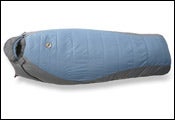I agree with your notion that synthetic will be best. I think downs reputation as an insulation that wets out too easily is a little overblownparticularly given the excellent materials used in sleeping bag shells these daysbut three weeks on the water warrants a bit of caution in this regard.
Big Agnes Crystal Sleeping Bag
 Big Agnes Crystal
Big Agnes Crystal
As for the mummy versus barrel (or semi-rectangular, to use the industrys jargon), its all a matter of space and weight. A roomy, semi-rectangular bag is definitely going to be more comfortable, and while that design is less thermally efficient, thats hardly an issue in this case (for you U.S. citizens, 0 Centigrade is 32 Fahrenheitin other words, quite mild).
So, which bag? One excellent choice would be Sierra Designs Lazer +30 (U.S. $190; www.sierradesigns.com). Its a mummy-style bag, but not a real snug one, that uses PrimaLoft Sport as insulation. I like PrimaLoft a lot as it feels softer and more down-like than some of the other synthetics out there, plus it is based on a polyester fiber, a naturally hydrophobic material that sheds water like a duck in the event of a dunking. The Lazer is rated to 30 degrees (F), and in warmer conditions has a zipper at the foot that can be unzipped.
Another good choice would be the Big Agnes Crystal (U.S. $149; www.bigagnes.com). This is a roomy, semi-rectangular bag thats also rated to 30 degrees (F) and that combines PrimaLoft Sport and 650-fill down. Its sort of best of both worldsthe softness and light weight of down, with the wet-conditions capability of synthetic.
A third bag I like is Mountain Hardwears 1st Dimension 30 (U.S. $155; www.mountainhardwear.com). Its rated to 30 degrees (F), a popular rating, and uses Polarguard Delta insulation, which I dont rate quite as highly as PrimaLoft but is a durable, proven material. One excellent feature in the 1st Dimension is that you can unzip a gusset in the bag shell and add eight inches of girth, or zip that closed for more thermal efficiency.
All of these bags weigh in the two-pound range and stuff down to a manageable size, so neither weight nor storage is an issue for a sea kayak trip.
Have fun, and stay safe.
The votes are in: , including the year’s hottest (no pun intended) sleeping bag.


